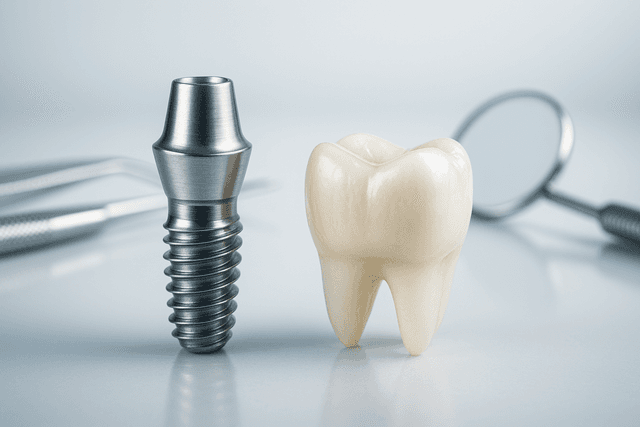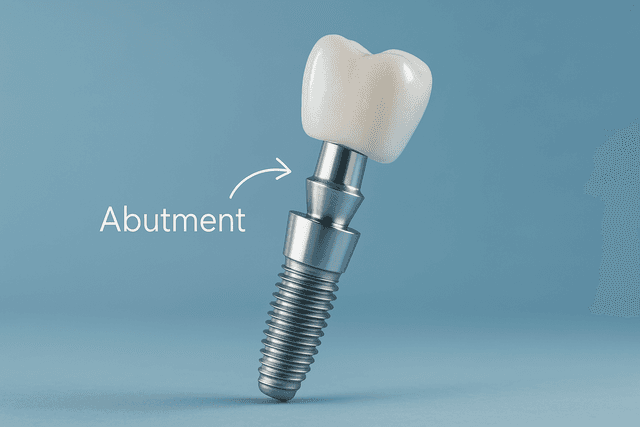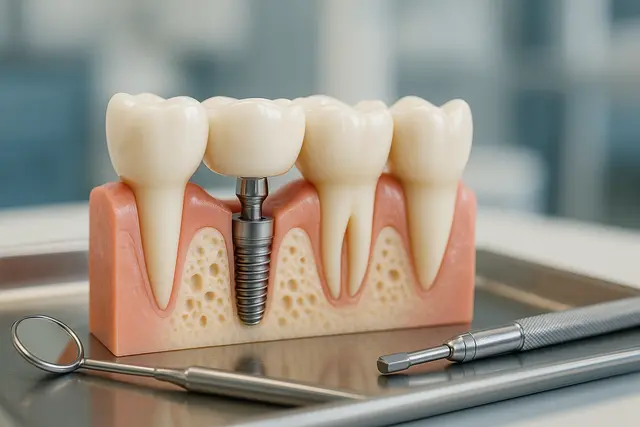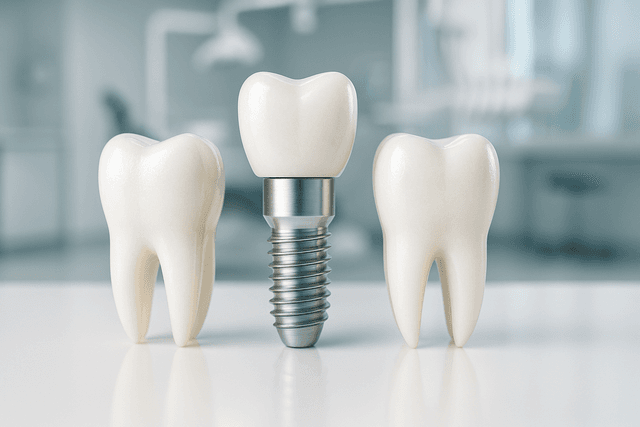Prosthodontics
5 min read
Oct 10, 2025
Implant Abutment vs. Crown Key Differences: A Detailed Breakdown
Missing a tooth isn’t just a cosmetic concern, it can affect how you eat, speak, and feel about your smile. Dental implants offer a modern solution, but understanding the parts involved, like the abutment and crown, can be confusing. This guide breaks down the key differences to help you make informed decisions about your oral health.

Dental Implant Basics: What You Need to Know
Let’s kick this off with a quick reality check. If you're here, you (or someone close to you) might be dealing with missing teeth. And that’s no small thing. Whether it’s chewing that first bite of pizza or flashing a smile in a photo, your teeth matter. That’s where a dental implant steps in to save the day.
An implant is basically a small titanium post that’s surgically placed into the jawbone. It becomes the strong, silent type that acts as a stand-in for your natural tooth root. And thanks to osseointegration (a fancy word meaning the implant fuses with the bone), it becomes rock-solid. Now, this titanium buddy doesn’t work solo. It needs some sidekicks: an abutment and a crown.
So what’s the real difference between an implant abutment and a crown? And why does it matter? Let’s break it all down.
Dental Crowns: The Visible MVP of Your Smile
The crown refers to the part of the tooth you actually see when someone smiles. It’s the visible part that does the chewing, the smiling, the selfie posing. In implant dentistry, the crown is the replacement tooth that’s custom-made to match your natural teeth. Whether it’s crafted from durable materials such as porcelain or zirconia, the dental crown is designed to look and feel like a natural tooth.
A crown is securely attached to the abutment (we’ll get to that guy next), and it’s what people notice most. It’s kind of like the star athlete who gets all the attention, while the abutment and implant do the behind-the-scenes work.
Abutment: Plays a Quiet Yet Crucial Role
The abutment is the connector. It’s a small component that’s attached to the implant post and acts as the bridge between the implant and the final crown. Once the implant integrates with the bone, the abutment is placed on top of the implant. Think of it as the middleman making sure your crown doesn’t go rogue.
A custom abutment can be crafted to perfectly fit your gum and crown. It allows the implant to support the crown in a stable, long-lasting way. And while it’s not the flashy part, without it, the whole structure falls apart. The abutment is the unsung hero of implant-supported crowns.
Implant Crown: How It All Comes Together
Here’s where things start to click into place, literally. The implant crown is the final touch. Once the abutment is attached to the implant, the crown is cemented onto the abutment or screwed in, depending on the type. This combo mimics the structure of natural teeth and gives you a smile that looks and functions just like the real deal.
An implant-supported crown and abutment crown work as a team. And yes, that sounds repetitive, but it’s worth highlighting: without this dream team, you’re just looking at a metal rod in the jaw. The crown is custom-designed to blend in with your other teeth, both in shape and color. Done right, no one will know it’s not your original tooth.
Dental Implant Procedure: A Quick Walkthrough
If you’re considering the dental implant procedure, it’s good to know the steps.
First, the titanium implant is surgically placed into the jawbone.
Then comes healing. This can take a few months, and a healing abutment may be used during this time to keep the gum from closing over the implant.
Once your bone has fused with the implant, the healing abutment is swapped out, and a permanent abutment is placed.
After that, your dental crown is designed and attached to the abutment.
And voilà, you’ve got a brand-new tooth that functions like a natural tooth.
Traditional Crown vs. Implant: A Key Difference
Let’s talk about traditional dental crowns for a second. These are used when your natural tooth is still hanging in there, but it needs protection, like after a root canal or major decay. In this case, the crown is cemented onto your existing tooth structure.
The key differences between dental implants and traditional crowns come down to what’s underneath:
Traditional crowns rely on your natural tooth.
Implants start from scratch and include the implant, abutment, and crown.
So if you’re replacing a missing tooth, implants are your go-to.
Understanding the Differences in Dental Implant Restorations
Let’s break down some quick-fire contrasts between implant and crown components:
The implant is surgically placed into the jawbone.
The abutment is a small connector piece that’s attached to the implant.
The crown is cemented or screwed onto the abutment.
Implant crowns help restore function and aesthetics.
Abutment is used to attach the crown and is placed on top of the implant.
Crown is the visible part and is designed to look like a natural tooth.
The entire dental implant process takes several months but offers long-term rewards.
These implant restorations work together to give you a sturdy, reliable replacement tooth. And unlike dental bridges or dentures, they don’t rely on other teeth for support. That means better dental health overall.
Dental Care and Maintenance: Post-Implant
Good news: dental implants can last a lifetime. But, and this is a big but, they only last if you take care of them. Maintaining good oral hygiene is non-negotiable. That means brushing, flossing, and keeping those dentist appointments.
The crown may need to be replaced over time due to wear and tear, but the implant itself? That titanium post isn’t going anywhere if you treat it right. Avoiding super hard foods and not using your new implant as a bottle opener (yep, people try) helps extend its life.
Replacing a Missing Tooth With High-Quality Dental Solutions
In cases where implants are needed, replacing a missing tooth isn’t just about looking good, it’s about protecting your jawbone, your bite, and your overall oral health. When a tooth goes missing, your jawbone can shrink, affecting other teeth and even the shape of your face. An implant using a small titanium post helps prevent that by keeping your jawbone active.
High-quality dental implants offer a permanent solution that feels and functions like a natural tooth. Whether it’s one tooth or several, modern dental practices have made tooth replacement more effective and less intimidating than ever before.
What Is the Difference Between an Abutment and a Crown in a Dental Implant?
The abutment and crown are two separate parts of a dental implant restoration. The abutment is a small connector piece that attaches to the implant post and supports the crown. The crown is the visible portion, the part that looks and functions like a natural tooth. While the abutment works behind the scenes to anchor the crown securely, the crown handles chewing, aesthetics, and daily wear.
Why Does the Abutment Matter in a Dental Implant?
The abutment plays a crucial structural role by connecting the implant post to the crown. Without it, the crown can’t be properly secured, and the implant wouldn’t function as a tooth replacement. Custom abutments are often used to ensure a precise fit with the patient’s gum contour and bite, which improves both appearance and durability.
How Is a Dental Implant Crown Attached?
After the implant post fuses with the jawbone, the abutment is placed, and the dental crown is either cemented or screwed onto it. Cement-retained crowns offer a seamless look, while screw-retained crowns allow easier access if repairs are needed. Both methods provide a strong, lifelike replacement for missing teeth when done properly.
Do Traditional Crowns and Implant Crowns Work the Same Way?
Not exactly. Traditional crowns are placed over existing tooth structures that have been shaped to support them, often after damage or decay. Implant crowns, on the other hand, are part of a three-piece system (implant, abutment, crown) used to replace completely missing teeth. Unlike traditional crowns, implant crowns don’t rely on natural tooth roots for support.
Read Next
Related Posts

Prosthodontics
Implant Abutment Explained: What It Is and Why It Matters
Dental implants have revolutionized the way we restore missing teeth, but there's more to them than just the visible crown. One often-overlooked component, the implant abutment, plays a crucial role in both the function and appearance of the final result. Understanding what it is and why it matters can make all the difference in your implant journey.
4 min read
Oct 10, 2025

Prosthodontics
Pros and Cons of Implant Retained Bridges: A Simple, Honest Overview
Missing teeth can affect more than just your smile, they can impact your confidence, speech, and even how you eat. With so many options out there, it’s easy to feel lost in dental jargon and marketing buzzwords. That’s why we’re breaking down implant retained bridges in plain English, highlighting the pros and cons so you can make an informed choice without the fluff.
6 min read
Oct 10, 2025

Prosthodontics
Implant Crown Lifespan: What to Expect
Getting a dental implant crown is a big step toward restoring both function and confidence in your smile. But like any dental work, it's natural to wonder how long it will actually hold up. From materials and maintenance to daily habits, several factors play a role in how long your implant crown will last.
4 min read
Oct 10, 2025
Don’t have time to research every dentist around you?
See why 30k+ patients trusted us